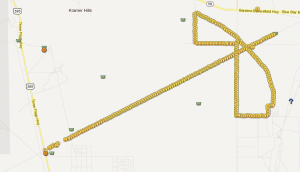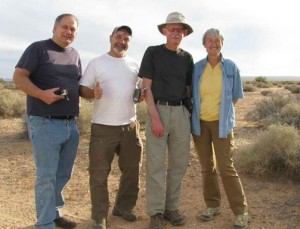This series, appearing on the map as a funny looking tomahawk, is designed as a so-called “power-caching trail,” with caches placed roughly 0.1 miles apart. I think a series like this is generally done by a team that uses a strategy that enables them to go really fast in finding the caches. I was curious how fast I could find them going solo.
Here’s how I worked it out:
- drive to next cache fast, monitoring GPS for where to stop
- slam on brakes, letting anti-lock brakes do their thing, leave engine running
- open door leaving it open, follow GPS arrow to correct side of car
- search for footprints to follow, or small pile of rocks next to a bush
- grab container, typically a film cannister, pop top off, unroll log, scribble facsimile of geocaching name, place log back in cache, pop top on, replace with rocks on top to keep the desert wind from blowing it away
- record find on GPS, select next closest, while walking back to car
- jump back in car, leaving seat belt off
- put in gear, floorboard accelerator, monitor roughness of road to determine max speed
- repeat, dozens of times
If I had wanted to be a die-hard, I could have continued after dark, but I called it a day, headed to the motel in Barstow, and had a nice dinner at DiNapoli’s Firehouse. As much as possible, I got organized to leave the motel early in the morning, and in fact I did manage that.
I started caching again about 7 am and finished about 11 am, finding another 92 caches. Somewhere along there I passed the 4,000 total finds milestone.
I ended this caching series with 250 finds, no DNFs (thanks, I think, to the Canadian caching crew who went just before me and replaced all the missing ones), and one very dusty truck (the result of slamming to a stop in a cloud of dust and leaving the door open).


Leave a Reply